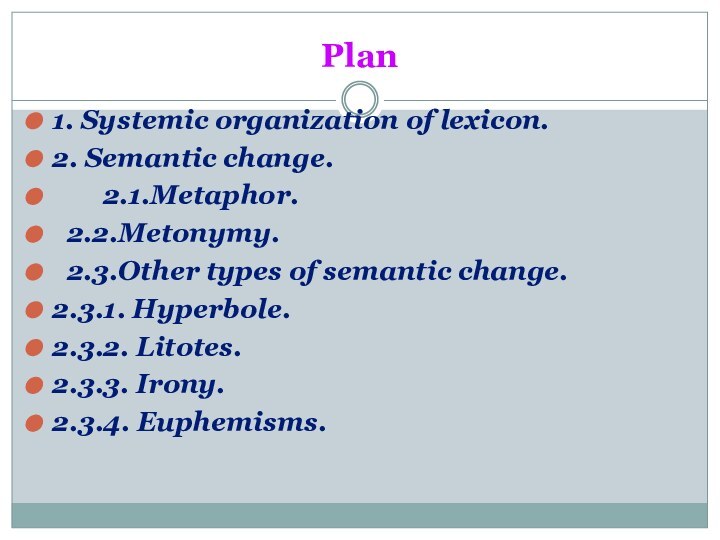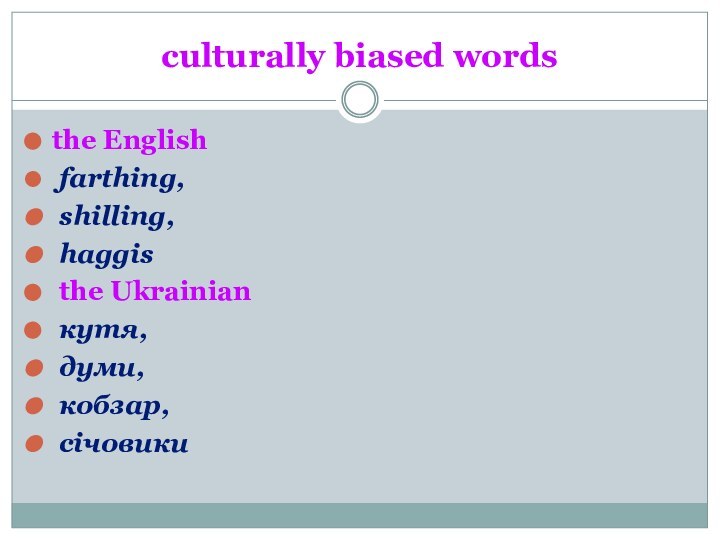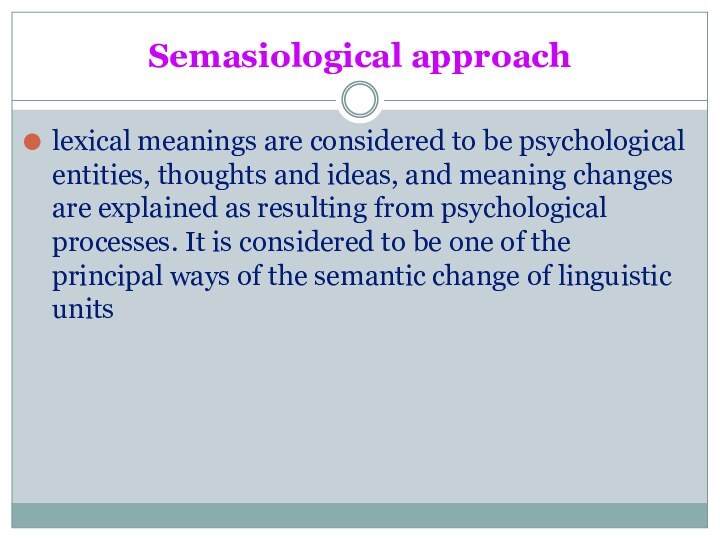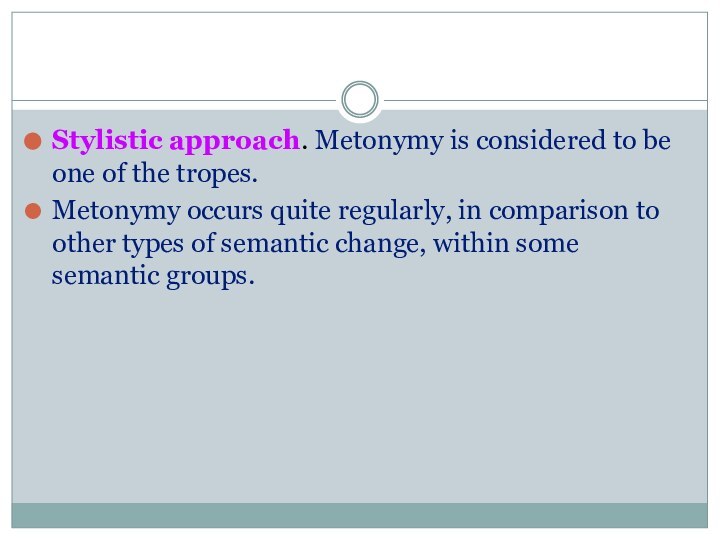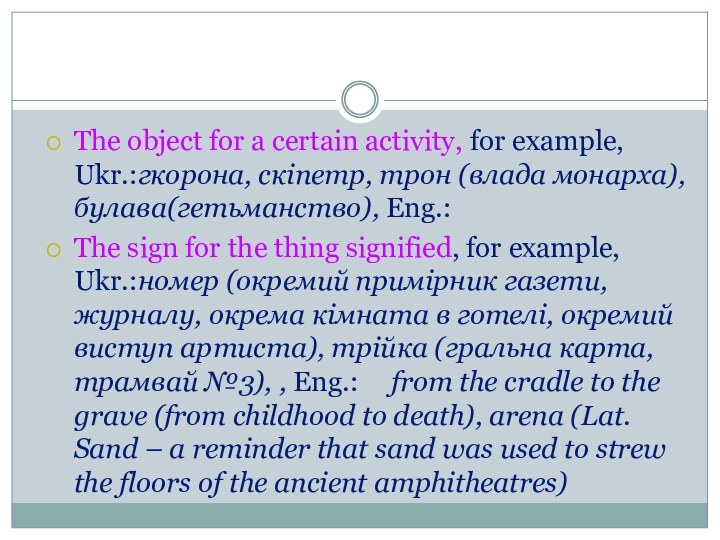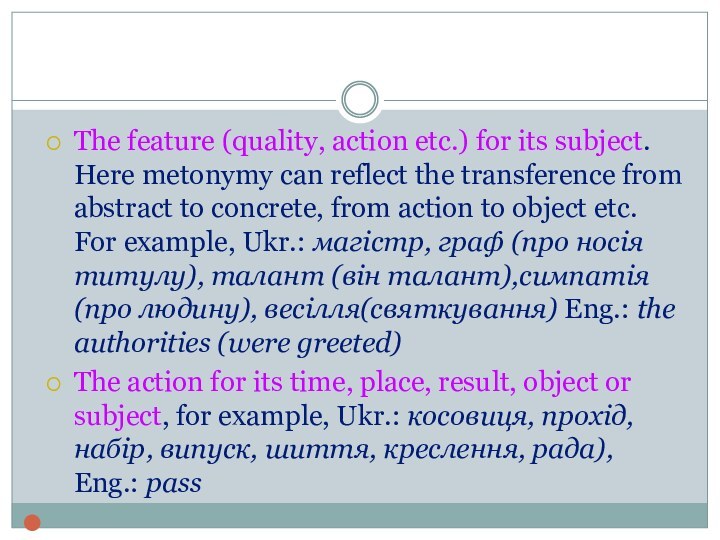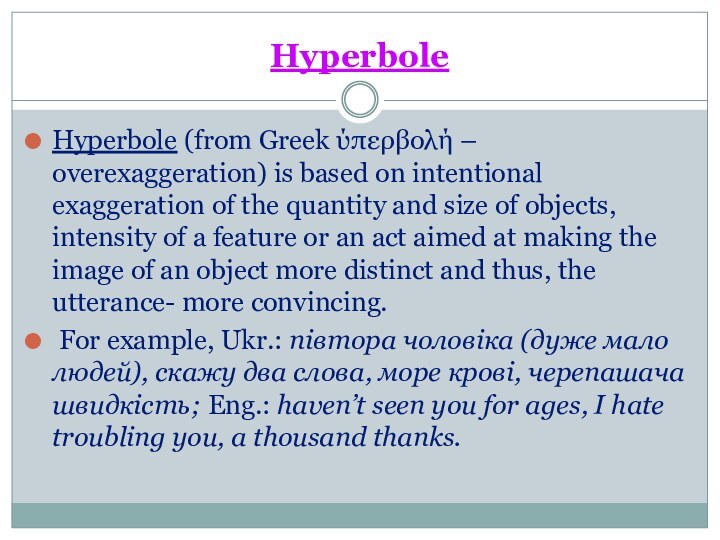Слайд 2
Lecture 10
Contrastive studies of the development of the
semantic structure of English and Ukrainian words
Contrast is the
occurance
of different elements
to create interest
Слайд 3
…..in every object there is inexhaustible meaning
Thomas Carlyle
Слайд 4
Plan
1. Systemic organization of lexicon.
2. Semantic change.
2.1.Metaphor.
2.2.Metonymy.
2.3.Other types of semantic change.
2.3.1. Hyperbole.
2.3.2. Litotes.
2.3.3. Irony.
2.3.4. Euphemisms.
Слайд 5
systemic organization of lexicon
conditioned in all languages
by lingual as well as by extralingual factors which
are of universal nature
The most important extralingual factors, predetermining the systemic organization of lexicon are:
a) physical and mental factors,
b) environmental factors,
c) social factors.
Слайд 6
common notions
the physical needs of human beings
…………………………………………..
mental
activity of man
…………………………………………..
natural environment of human beings
……………………………………………
social phenomena
as well as relationships and activities of man
…………………………………………….
…………………………………………..
Слайд 7
culturally biased words
the English
farthing,
shilling,
haggis
the Ukrainian
кутя,
думи,
кобзар,
січовики
Слайд 8
typologically relevant groups
universal lexicon
nationally specific lexicon
Trying to
compare universal lexicon of the two languages we proceed
from the idea that the basic lexicalization assumption should be explained within the framework of even more fundamental ideas of a language sign nature and its realization during its life.
Слайд 9
word semantic development
The assumptions about the most probable
direction of any word semantic development in its history
is the key point for understanding main lines of a possible mechanism for historical development of the entire language system.
This assumption has to deal with fact that there are more senses than words, so a word, at least potentially, is polysemous, possesses some degree of semantic uncertainty.
Слайд 10
polysemy
is a semantic universal inherent in the fundamental
structure of language.
Both in English and in Ukrainian
polysemy is widespread. But it is more characteristic of
English or Ukrainian?
The greater the relative frequency of the word, the greater the number of elements that constitute its semantic structure, i.e. the more polysemantic it is.
Слайд 11
“principle of diversity of meaning”
G.K.Zipf tried to find
a mathematical formula for it: his calculations suggested that
“different meanings of a word will tend to be equal to the square root of its relative frequency (with the possible exception of the few dozen most frequent words). Put in a different way m = F1/2
m stands for the number of meanings and F for relative frequency.
E.g. the total number of meaning registered in NED for the first thousand of the most frequent English words is almost 25 000, i.e. the average number of meanings for each these most frequent words is 25.
Слайд 12
metaphoric and metonymic transference of meaning
Metaphor (from Greek
μεταφορά – transposition ) is the result of the
semantic process when a form of a linguistic unit or expressing of a linguistic category is transposed from one object of designation to another on the basis of a certain similarity between these objects as reflected in the speaker’s mind. Metaphor is actually based on comparison.
It has been discussed by different linguists [ Shibles 1971, Тараненко 1980, Тараненко 1989, Арутюнова 1979, Телия 1988]
Слайд 13
Semasiological approach
lexical meanings are considered to be psychological
entities, thoughts and ideas, and meaning changes are explained
as resulting from psychological processes. It is considered to be one of the principal ways of the semantic change of linguistic units
Слайд 14
Onomasiological approach
is treated as the general principle
of nomination, e.g. in the process of lingual reflection
of the cognition of the surrounding world in the designation of:
relief by names of dishes (котел, жолоб),
sea flora and fauna by names of land and river creatures and plants (морські заяць, окунь, капуста),
means of transport – from water to air (летючий корабель, повітряний флот) and from land to water (річковий трамвай, водні лижі).
Слайд 15
Stylistic approach: metaphor is considered to be one
of the tropes.
Linguaphilosophic and ethnolinguistic approaches: metaphor is presented
as the way of world perception, simulation of the world and creating of the lingual picture of the world.
Слайд 16
Metaphorisation
Metaphorisation is most vividly represented on the lexical
level and we can discover a lot of common
features while analyzing linguistic metaphors in English and Ukrainian. Thus, the character of similarity making the basis of metaphors is basically the same:
1) Similarity by physical features:
form and sight, for example, Ukr.: стріла крана, гірський хребет, сонечко – комаха, Eng.:
Слайд 17
position, for example, Ukr.: голова колони,Eng.: foot of
the mountain, a page, back of the sofa
sounding, for
example, Ukr.: барабанити у двері, Eng.: drum fingers
peculiarities of movement, for example, Ukr.: коник – комаха, супутник – небесне тіло, Eng.:
peculiarities of functioning, for example, Ukr.: повітряний флот, English: leg of the chair, a bookworm
Слайд 18
2) Similarity by physiological and psychological impressions from
the perception of different objects:
Synesthetic. Synesthesy (from Greek συναίσΰησις
– simultaneous perception) is treated in linguistics as the reflection of the semantic structure of physiological associations between different types of senses. Synesthetic metaphors can be based on the perception of hearing, sight, touch, taste, for example, Ukr.: крикливий (одяг), високий/низький (звук), солодкий (запах, голос, обійми),Eng.: soft (voice)
Слайд 19
Most often such metaphors reflect the feeling of
touch, for example,
Ukr.: гострий(запах, блиск), м’який (голос, світло,
рух),
Eng.: soft (voice, colour), least often – smell.
Most productive directions of their development are spheres of sight and hearing.
Слайд 20
metaphors
Transference from the sphere of the physical world
to psychological and social spheres, to some abstract relations,
for example, Ukr.:горіти (завзяттям), гострий (розум), дрібний (урядовець), Eng.: , in particular, from space to time, for example, довгий(день)
Transference through actualization of a relatively indistinctive semantic feature, often of emotional-evaluative character, for example, горить (взуття), прірва (безліч)
Слайд 21
3) Similarity which exists only in the imagination
of the speaker and is only desirable for him,
for example, to give intimate colouring to communication one can address a person, who is not a good acquaintance or a relative, as друже, брате.
Слайд 22
S.Ullmann suggests the following types of transference:
a) anthropomorphic,
b) zoomorphic,
c) from concrete to abstract,
d) synesthetic,
e) from lexical units that attract a special attention of the society in that or other period.
The last type reflects the position of some lexical units on the scale of the social values of the society.
Слайд 23
E.g. “religious” and “agricultural” metaphors used to be
quite popular in Ukrainian (чорт, ірод, бусурман; нива, галузь,
сіяти добро), but now the accent is mostly on sports, technologies, space investigation, medical science (цейтнот, хід конем, орбіта інтересів, запрограмуватися на що-небудь, больові точки).
Слайд 24
Classification of the models of the metaphoric evaluative
lexical units is based on the opposition bad –
good which reflects the transference of the experience acquired in the physical world to the moral and social sphere. For example, „світло – морок” (світло знань – морок неуцтва), „тепло – холод” (теплий - холодний погляд), „відлига – заморозки” (у суспільстві), „верх – низ” (верхи - низи суспільства, висока - низька посада, підноситися – падати духом), „рух – непорушність” ( суспільний рух – застій) and others.
Слайд 25
metonymy
(from Greek μετωνυμία – renaming ) is the
result of the semantic process when a form of
a linguistic unit or expressing of a linguistic category is transfered from one object of designation to another on the basis of a certain contiguity of these objects conditioned by spatial, temporal, causal, symbolic, instrumental, functional and other relations as reflected in the speaker’s mind.
Слайд 26
approaches to metonymy treatment
1. Semasiological approach. It is
considered to be one of the principal
ways of the semantic change of linguistic units.
2. Onomasiological approach. It is treated as the general principle of nomination, for example naming of psychological phenomena on the basis of their external physiological expression, mimic, jests, for example, тремтіти – to be afraid, червоніти – to be ashamed, рвати на собі волосся – to be in despair
Слайд 27
Stylistic approach. Metonymy is considered to be one
of the tropes.
Metonymy occurs quite regularly, in comparison to
other types of semantic change, within some semantic groups.
Слайд 28
for nouns:
The container for the thing contained, for
example, Ukr.: склянка (випив склянку), зал (аплодував), місто (зустрічає
гостя), Eng.:a cup (drank a cup), a kettle (is boiling)
The material for the thing made of it, for example, Ukr.: чай, салат (рослина – страва), золото (вироби з нього) Eng.: marble (the statue made of marble), silver (coin), glass(articles made of glass)
The object for what is on it, for example, Ukr.:стіл (їжа), лікті (протерлися), Eng.: dish
Слайд 29
The object for a certain activity, for
example, Ukr.:гкорона, скіпетр, трон (влада монарха), булава(гетьманство), Eng.:
The sign
for the thing signified, for example, Ukr.:номер (окремий примірник газети, журналу, окрема кімната в готелі, окремий виступ артиста), трійка (гральна карта, трамвай №3), , Eng.: from the cradle to the grave (from childhood to death), arena (Lat. Sand – a reminder that sand was used to strew the floors of the ancient amphitheatres)
Слайд 30
The feature (quality, action etc.) for its subject.
Here metonymy can reflect the transference from abstract to
concrete, from action to object etc. For example, Ukr.: магістр, граф (про носія титулу), талант (він талант),симпатія(про людину), весілля(святкування) Eng.: the authorities (were greeted)
The action for its time, place, result, object or subject, for example, Ukr.: косовиця, прохід, набір, випуск, шиття, креслення, рада), Eng.: pass
Слайд 31
for verbs
Process the object in a way and
obtain, extract or liquidate something as the result, for
example, Ukr.: копати (землю/яму), доїти (корову/молоко), полоти (город/бур’ян), штопати (одяг/дірку), Eng.: to milk
The action of the subject and the state of the object, for example, Ukr.: протікає (вода/стеля), облазить (шкіра/спина)
Слайд 32
Metonymy frequently occurs in phraseological units, for example,
Ukr.: до сивого волосся (до старості), піднімати руки (здаватися
в полон)
English: to put one’s foot down
Слайд 33
Hyperbole
Hyperbole (from Greek ύπερβολή – overexaggeration) is based
on intentional exaggeration of the quantity and size of
objects, intensity of a feature or an act aimed at making the image of an object more distinct and thus, the utterance- more convincing.
For example, Ukr.: півтора чоловіка (дуже мало людей), скажу два слова, море крові, черепашача швидкість; Eng.: haven’t seen you for ages, I hate troubling you, a thousand thanks.
Слайд 34
Litotes
Litotes (from Greek λιτότης – simplicity) is aimed
at making the statement less categorical through the use
of indirect designation of a certain notion, namely through the negation of the notion that is opposite to the given. Litotes can be based on
negation, for example, Ukr.: не заперечую (погоджуюсь), неважко (легко); Eng.: no coward, not bad;
double negation, for example, Ukr.: така подія не видається неможливою. Not characteristic of English.;
without negation, for example, Eng.: I could do with a cup of coffee. Not characteristic of Ukrainian.
Слайд 35
Irony
Irony (from Greek είρωνεία – mockery) is the
type of the semantic change which occurs when a
word with a positive or assertive connotation (in a wide sense) is used to denote opposite characteristics. It is usually pronounced with a specific intonation, which in written form can be marked by inverted commas. For example, Ukr.: святий та божий, частувати (палицею), нагородити (стусаном), Eng.: a pretty mess.



